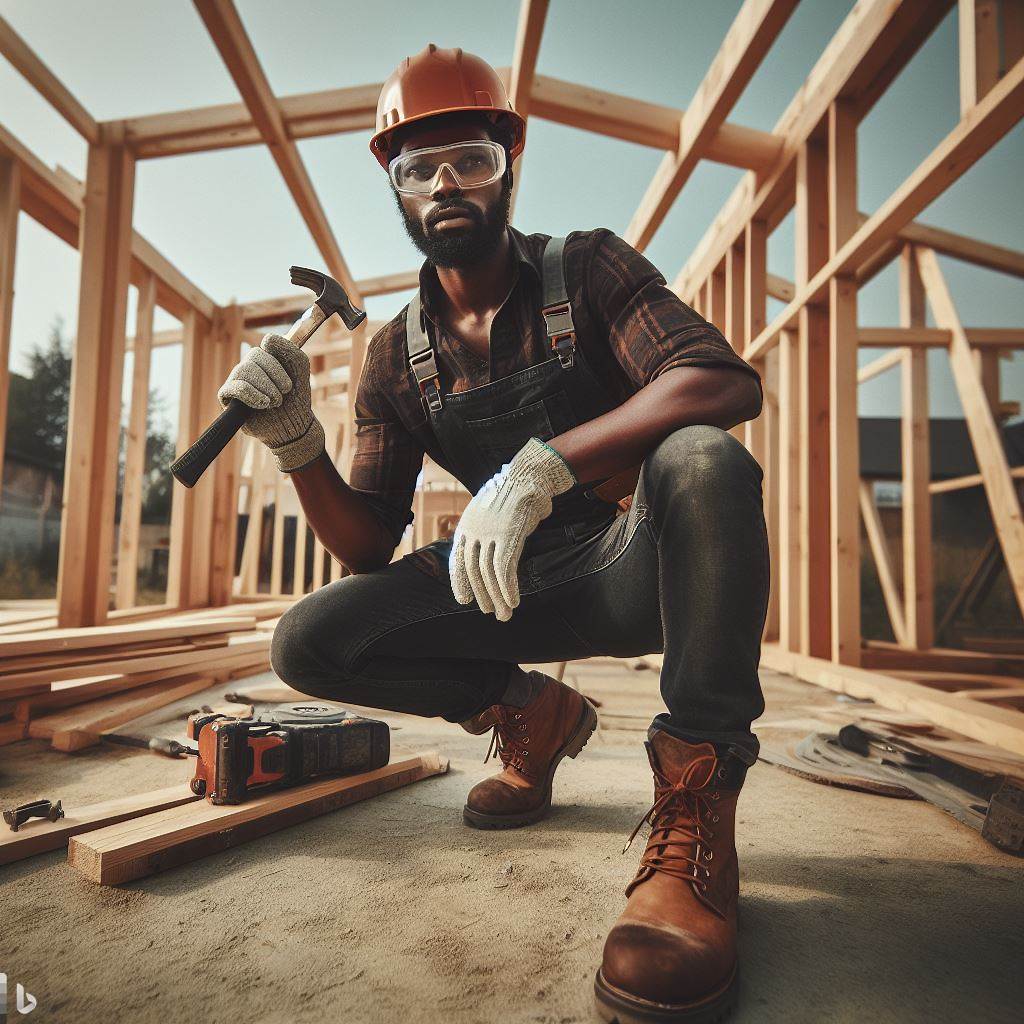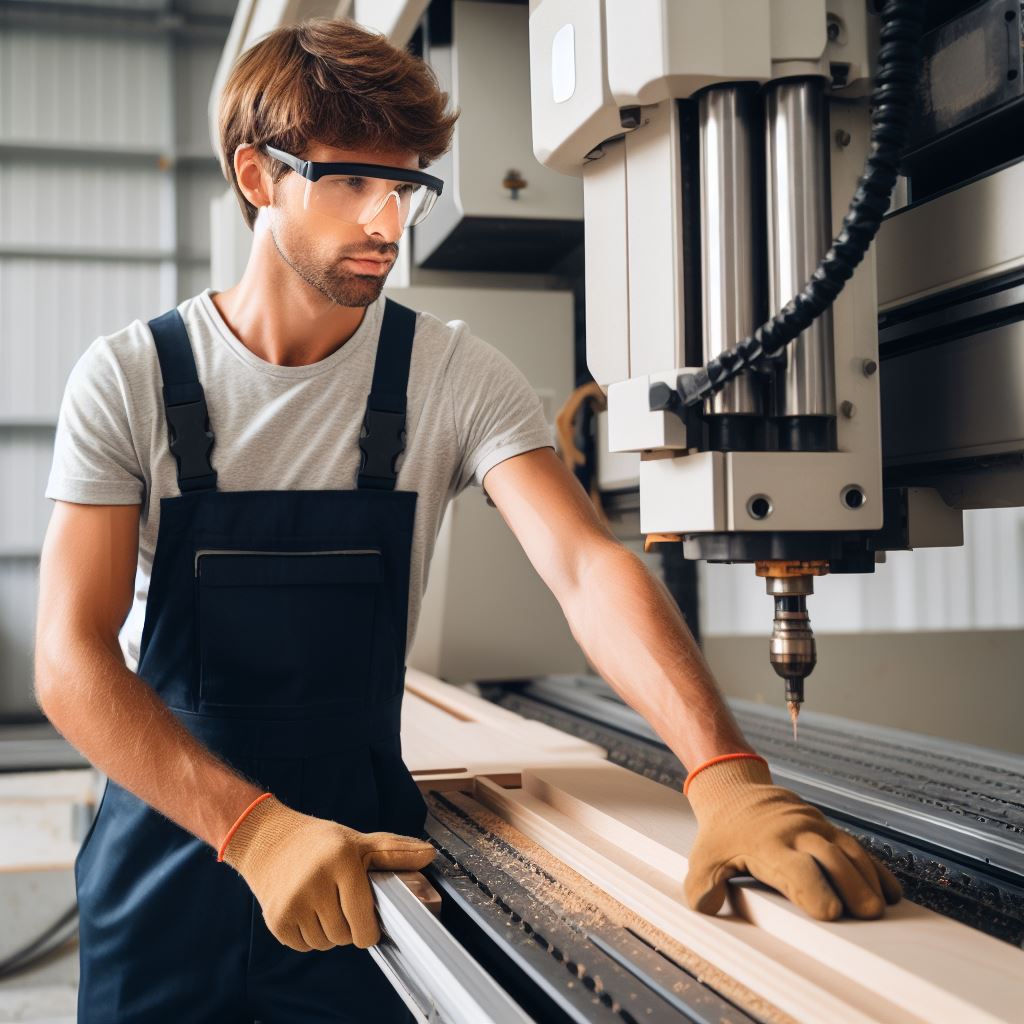Introduction
Safety protocols in carpentry are crucial to ensure the well-being of workers and prevent accidents.
These protocols are vital for maintaining a secure workplace.
Proper training and equipment are key elements in ensuring safety. To begin, always wear appropriate personal protective gear.
Safety glasses protect your eyes from flying debris. Earmuffs shield your hearing from loud machinery.
A dust mask keeps you safe from inhaling harmful particles.
Secure your clothing to avoid entanglement in machinery.
Be cautious around sharp tools and machinery. Keep a clean and organized work area to prevent tripping hazards.
Additionally, use guards on power tools to minimize the risk of accidents. Report any unsafe conditions or incidents immediately.
Following these safety protocols will create a safer environment for everyone in the carpentry industry.
Overview of carpentry safety protocols
Definition of safety protocols
- Safety protocols refer to a set of rules and guidelines that ensure the protection of workers in carpentry.
- These protocols are designed to minimize the risk of accidents, injuries, and fatalities.
- They cover various aspects such as personal protective equipment, tool handling, and hazard identification.
Brief history of safety protocols in carpentry
- The development of safety protocols in carpentry can be traced back to the Industrial Revolution in the late 18th century.
- As carpentry became more industrialized, the need for safety measures became evident.
- Early safety protocols focused on protecting workers from hazards such as falling objects and unguarded machinery.
- Over the years, safety protocols have evolved, incorporating advancements in technology and changing industry standards.
Importance of adhering to safety protocols in the American context
- Adhering to safety protocols is crucial in American carpentry to ensure the well-being of workers.
- The construction industry in the United States is known for its high rate of accidents and fatalities.
- By following safety protocols, carpenters can reduce the risk of accidents and create a safer work environment.
- Furthermore, adherence to safety protocols helps companies comply with legal regulations and avoid costly penalties.
Overall, safety protocols play a vital role in safeguarding carpenters and maintaining a productive and efficient work environment in American carpentry.
Implementing and following these protocols is not only essential for the well-being of the workers but also for the success of the projects.
It is important for carpentry companies to prioritize safety and invest in providing the necessary training and resources to their workers.
Some key safety protocols include wearing proper personal protective equipment (PPE) such as hard hats, safety goggles, and gloves.
Carpenters should also receive training on how to handle tools and machinery safely, minimizing the risk of accidents.
Regular inspections and maintenance of equipment and tools are crucial to identify any potential hazards and prevent accidents.
Creating a culture of safety is essential, where each worker takes responsibility for their own well-being and the safety of others.
Supervisors and managers should lead by example and enforce safety protocols to ensure compliance.
Regular safety meetings and toolbox talks can provide an opportunity to address any concerns, share best practices, and create awareness.
By adhering to safety protocols, carpenters not only protect themselves but also contribute to the overall success of the project.
A safe work environment enhances productivity, reduces downtime from accidents, and improves the reputation of the company.
Transform Your Career Today
Unlock a personalized career strategy that drives real results. Get tailored advice and a roadmap designed just for you.
Start NowFurthermore, safety protocols can also help attract skilled carpenters, as they prioritize working for companies that prioritize their well-being.
In essence, safety protocols are a critical aspect of American carpentry that cannot be overlooked.
They ensure the protection of workers, promote efficiency, and contribute to the success of projects.
By understanding and adhering to these protocols, carpenters can create a safe and productive work environment.
Essential safety practices in carpentry
Proper use of personal protective equipment (PPE)
Personal Protective Equipment (PPE) plays a vital role in ensuring the safety of carpenters. It includes items such as safety glasses, gloves, hard hats, and respiratory protection.
These protective gears safeguard carpenters from potential hazards and injuries on the job.
Tool and equipment safety measures
1. Regular maintenance and inspections
To ensure the safe operation of tools and equipment, regular maintenance and inspections are essential.
This includes checking for loose or damaged parts, replacing worn-out components, and lubricating moving parts. Regular inspections help identify potential hazards and prevent accidents.
2. Correct handling and storage
Proper handling and storage of tools and equipment minimize the risk of accidents. Tools should be used as intended and not modified or altered.
They should also be stored in designated areas to prevent tripping hazards.
Workplace safety
1. Clean and organized work environment
Maintaining a clean and organized work environment is crucial to promoting safety in carpentry.
Debris, sawdust, and other clutter should be promptly removed to prevent slips, trips, and falls.
Tools should be properly stored when not in use.
2. Proper disposal of waste materials
Carpentry often produces waste materials such as sawdust, wood scraps, and packaging materials.
These should be disposed of properly to prevent fire hazards and potential injuries.
Recycling or proper waste disposal practices should be implemented.
3. Safe handling of hazardous substances
Carpentry may involve the use of chemicals such as adhesives, paints, and solvents. These substances can be hazardous if not handled properly.
Carpenters should use protective equipment and follow safety instructions when working with these materials.
Ergonomic practices
1. Proper body mechanics and lifting techniques
Carpenters often engage in manual lifting and carrying heavy objects.
Showcase Your Business Today
Reach thousands of readers actively exploring professional services. Publish your business profile and grow your audience now.
Publish NowUsing proper body mechanics and lifting techniques can prevent back and muscle injuries.
This includes bending from the knees, keeping a straight back, and using mechanical aids when necessary.
2. Avoidance of repetitive motion injuries
Carpenters may perform tasks requiring repetitive motions, such as sanding or cutting.
These repetitive motions can lead to injuries like tendonitis or carpal tunnel syndrome.
Taking regular breaks, using ergonomic tools, and practicing stretching exercises can help prevent these injuries.
By following these essential safety practices, carpenters can reduce the risk of accidents and injuries in their profession.
Prioritizing safety not only protects the well-being of the carpenters but also ensures efficient and successful carpentry projects.
Read: Carpentry Schools in the USA: Top Picks & Programs
Specific safety protocols for different carpentry tasks
When it comes to carpentry, safety protocols are of utmost importance to prevent accidents and ensure the well-being of everyone involved in the construction process.
This section focuses on specific safety protocols for different carpentry tasks, including framing, finishing, roofing, and specialty carpentry.
Framing safety protocols
- Properly handle and install structural components to ensure stability and prevent accidents. This includes using appropriate tools and techniques.
- Implement fall protection measures, such as using harnesses and guardrails, when working at heights. This helps prevent falls and serious injuries.
Finishing safety protocols
- Safely use power tools for sanding and polishing by following manufacturer’s instructions and wearing protective gear. This prevents injuries from tool malfunctions or flying debris.
- Handle and dispose of finishing chemicals properly to avoid health hazards and environmental contamination. Follow safety data sheets and local regulations for safe disposal.
Roofing safety protocols
- Implement fall prevention and protection mechanisms, such as installing guardrails and safety nets, to reduce the risk of falls. Regularly inspect and maintain these safety measures.
- Properly set up and use ladders and scaffolding, ensuring stability and following safety guidelines. This includes checking for defects before using and using non-slip materials on working platforms.
Specialty carpentry safety protocols
- Consider unique safety considerations for each specialty task, such as cabinetry or flooring. This may include handling specialized tools or materials, and following specific installation techniques.
In fact, adhering to specific safety protocols is crucial for different carpentry tasks.
Whether it’s framing, finishing, roofing, or specialty carpentry, following these protocols promotes a safe working environment and prevents accidents.
Carpenters should always prioritize safety and stay updated on the best practices in their field.
Read: Key Tools and Techniques Every US Carpenter Should Know

Training and education for carpenters regarding safety protocols
Importance of safety training
- Safety training plays a crucial role in carpentry to prevent accidents and injuries.
- It helps carpenters understand potential hazards and how to mitigate them effectively.
- By receiving proper training, carpenters can create a safer work environment for themselves and others.
- Safety training instills a sense of responsibility and professionalism in carpenters.
Availability of training programs
- Numerous training programs are available to help carpenters acquire the necessary safety knowledge and skills.
- Local trade associations, such as the American Carpenters Association, often provide safety training programs.
- Many community colleges offer courses focused on occupational health and safety for carpenters.
- Carpenters can also find online training programs that provide convenience and flexibility in learning.
Recommended resources for carpenters to learn about safety protocols
- OSHA (Occupational Safety and Health Administration) website is a valuable resource for carpenters to access safety information.
- The OSHA’s Construction Safety and Health Outreach Program offers training materials specifically designed for carpenters.
- Safety handbooks and manuals, like “Safe Carpentry Practices” by John Smith, provide comprehensive guidance on safety protocols.
- Attending workshops and conferences related to carpentry safety can enhance carpenters’ knowledge and skills.
Carpenters prioritize safety through continuous training, recognizing the risks of the construction industry.
Specialized programs enhance their competence in recognizing hazards and using tools safely.
Various options, including trade associations, community colleges, and online training, provide accessible courses on topics like fall protection, scaffolding safety, and power tool usage.
The OSHA website serves as an informative resource, offering specific carpentry safety guidelines.
The OSHA’s Construction Safety and Health Outreach Program provides valuable training modules and materials.
Furthermore, safety handbooks and manuals authored by industry experts serve as comprehensive references.
Carpenters can enrich their knowledge by attending safety-focused workshops and conferences, promoting best practices and networking.
Most important, investing in safety training is paramount, ensuring the well-being of carpenters and the success of construction projects.
Various resources are available for carpenters to enhance their knowledge and skills in safety practices, making it easier for them to navigate potential hazards and create a safer work environment.
Read: The Historical Evolution of Carpentry in the USA: A Deep Dive
Benefits of Following Safety Protocols in Carpentry
Reduction in Workplace Accidents and Injuries
Following safety protocols in carpentry is essential as it significantly reduces workplace accidents and injuries.
By implementing these protocols, carpenters can create a safer work environment, preventing potential hazards and accidents.
The use of protective gear such as safety goggles, gloves, and helmets, helps mitigate the risk of injuries.
By wearing these items, carpenters protect themselves from flying debris, sharp objects, and other potential dangers.
In addition, following safety protocols leads to proper handling and storage of tools and materials. This reduces the likelihood of accidents caused by improper tool usage or falling objects.
Improved Productivity and Efficiency
Implementing safety protocols positively impacts productivity and efficiency in carpentry.
When carpenters prioritize safety, they can work more efficiently, focusing on their tasks rather than worrying about potential accidents.
Following safety protocols minimizes downtime caused by injuries, as workers are less likely to experience accidents when they adhere to safety guidelines.
This allows carpenters to complete projects without interruption, ultimately increasing overall productivity.
Furthermore, safety protocols promote organization and cleanliness in the workplace.
Tools and materials are properly stored and maintained, reducing the time wasted searching for necessary items.
A well-organized workspace enhances efficiency and enables carpenters to work more effectively.
Positive Reputation for Carpenters and Their Businesses
By following safety protocols, carpenters and their businesses develop a positive reputation within the industry.
Clients and stakeholders place high value on the safety standards maintained by carpenters, making them a trusted choice for construction projects.
Building a reputation for safety indicates professionalism and dedication to quality work.
Potential clients are more likely to consider carpenters who prioritize safety, knowing that their project will be completed without incident and with a focus on the wellbeing of all involved.
Showcase Your Business Today
Reach thousands of readers actively exploring professional services. Publish your business profile and grow your audience now.
Publish NowMoreover, a positive reputation attracts more clients, leading to increased business opportunities.
Word-of-mouth recommendations from satisfied clients who have witnessed the adherence to safety protocols further enhance a carpenter’s reputation.
Legal and Regulatory Compliance
Following safety protocols ensures legal and regulatory compliance in the carpentry industry.
Laws and regulations are in place to protect workers and their rights, and adherence to these protocols avoids legal complications and penalties.
Carpenters who adhere to safety regulations demonstrate their commitment to respecting legal requirements.
This not only safeguards the workers but also protects the reputation and financial stability of their businesses.
Compliance also extends to insurance requirements, as insurance providers often require proof of safety protocols before providing coverage.
By following these protocols, carpenters can ensure they meet the necessary criteria and protect themselves from financial risks associated with accidents or injuries.
In review, following safety protocols in carpentry provides numerous benefits.
It reduces workplace accidents and injuries, improves productivity and efficiency, builds a positive reputation, and ensures legal and regulatory compliance.
Carpenters who prioritize safety create a safer and more successful work environment for themselves and their businesses.
Read: A Day in the Life of a U.S. Mechanical Engineer
Explore Further: Navigating the American Welding Society (AWS) Certification Path
Conclusion
Recap of key points discussed
- Safety protocols are crucial in American carpentry for accident prevention.
- Proper training and education can ensure adherence to safety measures.
- Using personal protective equipment (PPE) is essential to minimize injuries.
- Regular inspections help identify potential hazards that need immediate attention.
- Creating a culture of safety within the workplace promotes a secure working environment.
Encouragement to prioritize safety protocols in carpentry
It is vital to prioritize safety protocols in carpentry to protect yourself and your team.
By implementing strict safety measures, you can prevent accidents, serious injuries, and even fatalities.
Don’t compromise safety for speed; working safely may take a little longer, but it’s worth it.
Final thoughts on the importance of maintaining a safe working environment
The well-being of carpenters should always be at the forefront of any woodworking project.
By maintaining a safe working environment, you not only protect yourself but also your colleagues.
Remember, safety is not just a priority; it’s an essential practice that should never be overlooked.
Investing time and effort in implementing and following safety protocols is beneficial in the long run.
By creating a secure workplace, you can complete projects efficiently while ensuring everyone’s well-being.
[E-Books for Sale]
The Big Book of 500 High-Paying Jobs in America: Unlock Your Earning Potential
$19.99 • 500 High-Paying Jobs • 330 pages
Explore 500 high-paying jobs in America and learn how to boost your career, earn more, and achieve success!
See All 500 High-Paying Jobs of this E-Book
1001 Professions Without a Degree: High-Paying American Jobs You Can Start Now
$19.99 • 1001 Professions Without a Degree • 174 pages
Discover 1001 high-paying jobs without a degree! Unlock career tips, skills, and success strategies for just $19.99!




